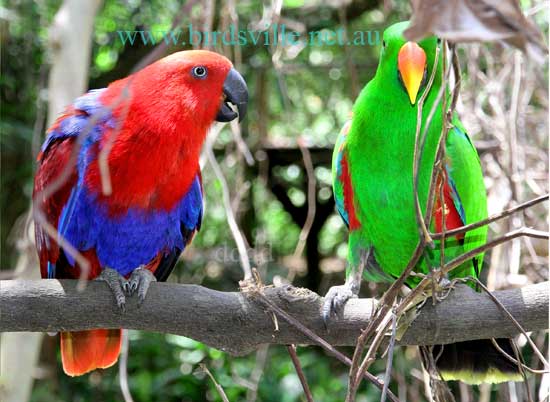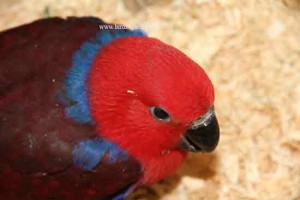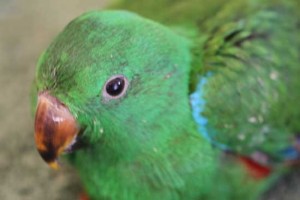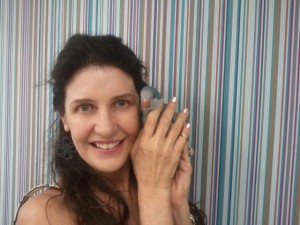Eclectus Parrot care guide

The Eclectus parrot
Sexually dimorphic with roughly ten sub-species which all stem from the dominant race of the “grand Eclectus”. They can be found in many locations around the world such as New Guinea, the Solomon Islands, Cape York Peninsula and Australia. For these birds, intelligence is the key. In Australia Red sided Eclectus are the most common followed by the Vosmaeri Eclectus, sadly a lot of people are being sold birds online from websites etc believing they have purchased a different sub species such as Grand Eclectus or Vosmaeri but they are actually red sided Eclectus.. These birds are very difficult to tell apart with an untrained eye, I have not found any difference between temperament with the different species.
In the wild they are arboreal rainforest birds living in small family groups spending the majority of their time in the treetops.
Eclectus parrots as pets are beautiful to look at as well as being an active member of the family! They live for around 45 years and are reasonably easy to breed. They are very good talkers and will always surprise you with how fluent their words are pronounced.
Bring a new Eclectus home Care sheet
Length
around 34 CMS
Weight
430 – 550 Grams

Cage’s For Tame Eclectus parrot’s
As with any bird, there is no such thing as a cage too big! It is recommended that you house your bird in the largest cage you can afford; this will benefit the wellbeing of your bird.
Make sure you decorate their cage with toys that they can chew, swing and play on. This will not only make your bird much happier, but it will greatly decrease the chances of your bird developing bad habits like feather plucking or excessive squawking.
Diet For Hand Raised Eclectus Parrot’s
In the wild eclectus parrots are omnivorous eating both fruit, vegetables and meat. This is why most pet birds relish meat when it is offered to them.
Hand Raised Eclectus parrots should be fed a healthy diet which includes fruit, vegetables, seed, minerals, calcium, figs and even some types of flowers! With a healthy diet, your Eclectus parrot will become very robust. Vitamin and mineral supplements should be given regularly. Do not feet your Eccy parrot grit.
Have separate bowls for your seed and pellet’s is much more cost effective. For adult Eclectus Do not replace seed or pellet’s until they are both finished. Many people will replace the seed before the pellets are finished, given the choice they will always.
Seed – Always feed your Eclectus a good quality seed mix. Be wary of many supermarket seed mixes as they can be of poor quality. If you are unsure of the seed mix you are using, ask your local bird expert. I have always fed my Eclectus small parrot mix, but some people will feed them budgie mix, we also have a very popular Birdsville mix in store with no sun flower seed.
Adult Eclectus seed we recommend feeding small parrot mix as it has less sunflower seed.
Baby Eclectus seed we recommend parrot mix or small parrot mix as it has more sunflower seed this high fat diet should be changed before your eclectus is 6 months old.
Soaked seed – for information on preparing soaked seed visit Eclectus Parrot, soaked seed is great for all parrots of all ages and especially young birds as its easy for them to consume and releases more nutrition.
Fruits and veg– You can never give your Eclectus too much fruit and veg, Rock melon, Honey dew, Corn, Apple, Sweet potato, Carrot, pomegranate, pears, banana, leafy greens, broccoli, capsicum, zucchini, spinach, broccoli, cucumber, green beans, chilli, and stone fruit to name a few.
Frozen peas and corn may be added to their fruit and vegetables.
Pellets well suited for eclectus are Paradise vetafarm pellets.
Fresh water must be available at all times.
Do not feed your Eclectus Avocado, Lettuce, cocoa or anything containing cocoa or shell grit.
Warning– Do not feed your bird avocado lettuce, chocolate or onion.
Introducing your new bird to existing birds
Once you take your bird home you should keep it in a separate cage and allow the bird to adjust accordingly. Always allow at least 2 weeks before introducing the bird to an existing bird.

Hygiene
The cage requires regulars cleaning and old food shouldn’t ‘be allowed to accumulate in the cage, on perches or in feeders. Water should be changed daily basics.
Worming
Your bird will need to be wormed in a few weeks to two months after being taken home (check with the staff from Birdsville, when purchasing). Worming will need to be done every 6 months. Eclectus Parrots have a long digestive tract and absorb everything more easily than other parrots, so we recommend using half the amount of wormer when worming. SO, you place half the wormer that it recommends on the bottle. Eclectus Parrots due to having a long digestive tract absorb more than other birds, so they only need half the recommended amount of wormer in the water that a normal parrot would use.
Lice & Mites
These are the two most common parasites of cage birds and their environment but are easily controlled with a Mite and Lice spray, available at Birdsville. When using spray, spray bird, entire cage, perches, nesting box and toys, remember to remove all water and feed and avoid spraying in birds’ eyes.
Training Eclectus parrot’s
This is an important factor of having a well-behaved hand raised bird. The bird need.
to be handle in a quiet, relaxed situation, but don’t over stress your bird in the first few weeks of taking it home. Positive reinforcement is key to training birds and any good behavior is rewarded with treats, praise and cuddles. It is important that you establish trust with your bird if you hit your bird for biting the bird will often become much worse. Never ever hit your bird. The more time you spend with your bird, the better your bird will become. Training Eclectus parrots
Enrichment For Eclectus parrot’s
Toys are used as a form of environmental enrichment, but enrichment shouldn’t stop there. As an ex-zookeeper it was a major concern that all animals must have a variety environmental enrichment to keep the critters entertained. This is in no way different for anyone who has a tame parrot at home. Enrichment is important because parrots simply cannot thrive with only perches, food and water. The fact is birds provided with enrichment are unlikely to develop psychological problems such as self-mutilation, feather plucking and excessive squawking. Enrichment WILL in fact effect your bird in a positive way with its mental and physical development when training your bird, you will actually end up with a better, less fearful, friendlier and relaxed bird which will be more easily trained. Enrichment can be chew toys, play toys, leather toys, acrylic plastic toys, wooden toys, shredding toys, ropes, swings, ladders, bells, balls, birdie balls, plain card board, small boxes, wicker baskets, tray of wheat grass, plants, bird baths, different foods, food kabobs, nuts, (all available at birdsville) You may also find in your local area pine cones, hide food inside pine cones, twigs, bendy branches, flowers and branches- safe flowers are bottle brush, grevilia, eucalypt melaleuca flowers, hibiscus, marigolds, dandy lions leaves and all, roses, violets to name a few.
Note anything found outside should be disinfected and non poisonous and toys must be nontoxic.
Enrichment tip- the trick to keeping them entertained is regularly rotating toys as they will become bored with the same toy in their cage day after day. Changing them regularly will create interest for your bird as if they are receiving a whole new toy to play with.
Hand Raising Baby Eclectus
For more details on hand raising visit our hand raising baby bird’s page
None of our baby eclectus are hand raised from any younger than 3 weeks of age. This in my experience gives the would-be owner a much healthier and stronger bird as in the first stages of life the baby has had a chance to get all the important good bacteria from the parents and have a strong resistance to disease for the rest of the bird’s life. For the next 2 months of hand rearing the bird will very quickly learn to trust and get confidence. All our babies are fed with crop needles which is more hygienic for the youngster. The crop needle is not actually inserted into the crop as they actually feed from the rounded tip of the feeding apparatus. During the growing stages our birds get used to being fed and handles by different people including, males, females and are exposed to different noises of people talking vacuum cleaners, phones, music etc.
This is one way of feeding baby eclectus parrots, i prefer to use a crop needle as its much less mess and more hygienic for the babies as they grow their feathers around the chest area. Despite my opinion i have seen good results from both methods.
Bringing your Eclectus home for the first time
First 3 days– Give your Eccy time to adjust to the new environment do not play with the bird too much or let the bird become stressed. They need some time to simply adjust to the new environment.
For the first 6 weeks– Give your eclectus parrot a wide varied diet and an all you can eat buffet with seed, pellets and plenty of fruit and veg. I am strongly against too much seed over pellets for any eclectus but this does not include birds that have recently weaned. As young birds that have been recently located to a new environment can revert back into the sooky baby stage and stage. This is a risk as a young bird can stop eating and that is bad. I would recommend new owners of birds that are weaned to still consider getting some hand rearing formula that they will happily eat off a spoon. On the upside eclectus love hand rearing formula and i actually use this to train my birds to come to me and is a great way to get birds to bond with their owner.
Introducing your Eclectus to an Eclectus you already own– This should be done properly as they can sometimes take time to get to know each other. The best way is to have them in 2 separate cages next to each other so they can see and look at each other for at least a month before introducing them together.
Trimming your Eclectus parrot’s nails– There are a number of cement perches available at Birdsville that will do the job for you, or we will trim your birds’ nails for $15 in store. If you choose to do them yourself, be very careful.
Visually check my bird is healthy.
- Firstly, the birds muscle mass around the chest area if the bird’s keel bone sticks out and the bird feels light you may need to visit a vet.
- Eyes clear
- Feathers in good condition this can vary if bird is molting.
- feet strong
For more information on Breeding Eclectus visit Eclectus Parrot



